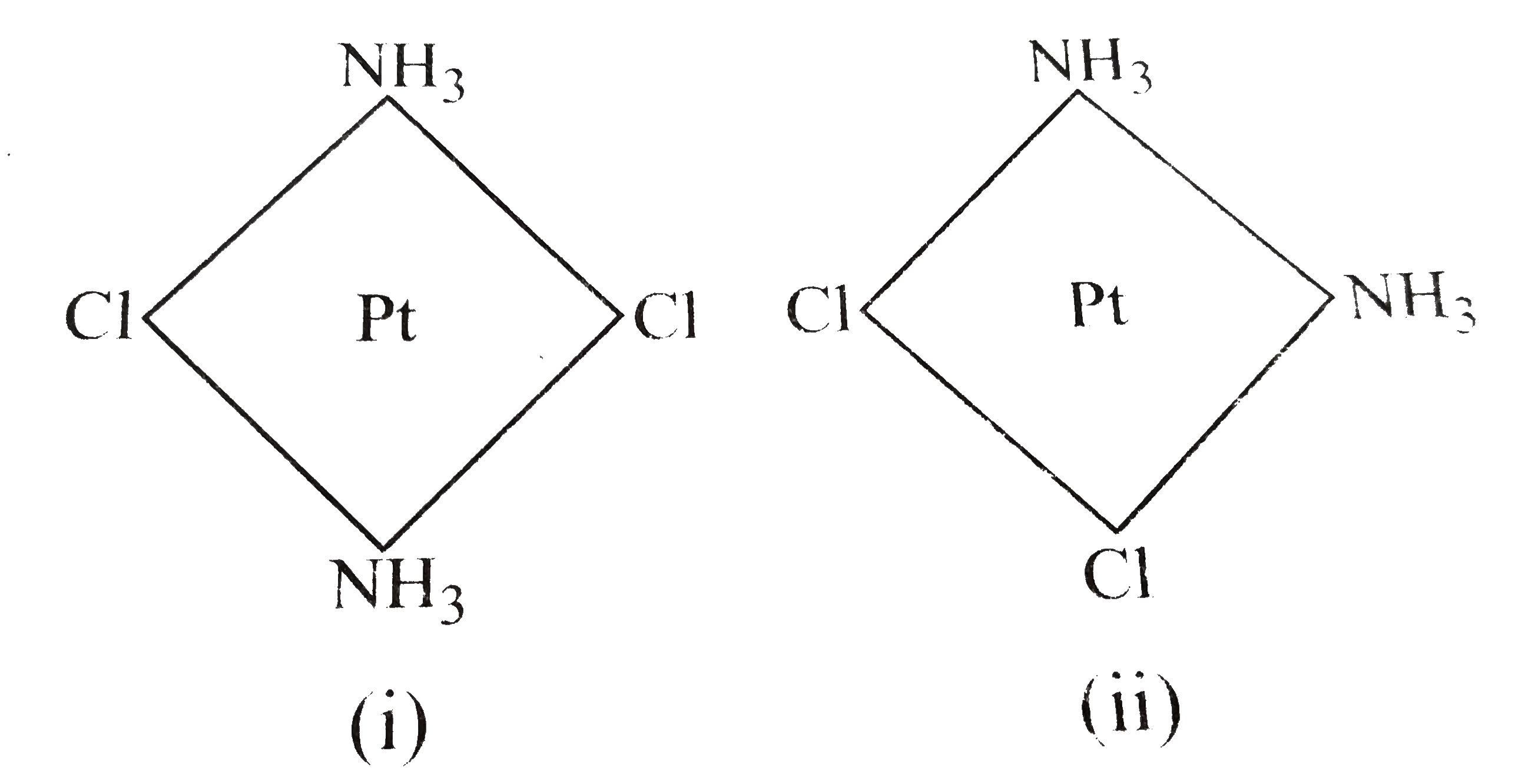The CI−C−CI angle in 1,1,2,2, tetrachloroethone and tetrachloromethane respectively will be about:
109.5∘ and 90∘
120∘ and 109.5∘
90∘ and 109.5∘
109.5∘ and 120∘
The correct Answer is:B
To determine the C−Cl−C angle in 1,1,2,2-tetrachloroethane and tetrachloromethane, we need to analyze the molecular structures of both compounds and their hybridization states.
1. Identify the Structure of 1,1,2,2-tetrachloroethane:
- The name indicates that we have an ethane backbone (C-C) with chlorine atoms attached.
- The structure can be represented as:
ClCl||C=C||ClCl
- In this structure, each carbon atom (C) is bonded to two chlorine (Cl) atoms.
2. Determine the Hybridization of Carbon in 1,1,2,2-tetrachloroethane:
- Each carbon atom in this compound is involved in a double bond (C=C), which means they are sp² hybridized.
- The bond angles in sp² hybridization are approximately 120 degrees.
3. Identify the Structure of Tetrachloromethane:
- Tetrachloromethane (CCl₄) has a central carbon atom bonded to four chlorine atoms.
- The structure can be represented as:
Cl|Cl−−C−−Cl|Cl
- Here, the carbon atom is surrounded by four chlorine atoms.
4. Determine the Hybridization of Carbon in Tetrachloromethane:
- The carbon atom in tetrachloromethane is bonded to four chlorine atoms, which means it is sp³ hybridized.
- The bond angles in sp³ hybridization are approximately 109.5 degrees.
5. Conclusion:
- The C−Cl−C angle in 1,1,2,2-tetrachloroethane is about 120 degrees.
- The C−Cl−C angle in tetrachloromethane is about 109.5 degrees.
Final Answer:
- The C−Cl−C angle in 1,1,2,2-tetrachloroethane is approximately 120 degrees, while in tetrachloromethane, it is approximately 109.5 degrees.
- The name indicates that we have an ethane backbone (C-C) with chlorine atoms attached.
- The structure can be represented as:
ClCl||C=C||ClCl
- In this structure, each carbon atom (C) is bonded to two chlorine (Cl) atoms.
- Each carbon atom in this compound is involved in a double bond (C=C), which means they are sp² hybridized.
- The bond angles in sp² hybridization are approximately 120 degrees.
- Tetrachloromethane (CCl₄) has a central carbon atom bonded to four chlorine atoms.
- The structure can be represented as:
Cl|Cl−−C−−Cl|Cl
- Here, the carbon atom is surrounded by four chlorine atoms.
- The carbon atom in tetrachloromethane is bonded to four chlorine atoms, which means it is sp³ hybridized.
- The bond angles in sp³ hybridization are approximately 109.5 degrees.
- The C−Cl−C angle in 1,1,2,2-tetrachloroethane is about 120 degrees.
- The C−Cl−C angle in tetrachloromethane is about 109.5 degrees.
- The C−Cl−C angle in 1,1,2,2-tetrachloroethane is approximately 120 degrees, while in tetrachloromethane, it is approximately 109.5 degrees.
Topper's Solved these Questions
- CHEMICAL BONDING AND MOLECULAR STRUCTURE BOOK - AAKASH INSTITUTE ENGLISHCHAPTER - CHEMICAL BONDING AND MOLECULAR STRUCTURE EXERCISE - Assignment Section - B Objective Type Questions(One option is correct)
37 Videos
- CHEMICAL BONDING AND MOLECULAR STRUCTURE BOOK - AAKASH INSTITUTE ENGLISHCHAPTER - CHEMICAL BONDING AND MOLECULAR STRUCTURE EXERCISE - Assignment Section - C Objective Type Questions(More than one options are correct )
13 Videos
- CHEMICAL BONDING AND MOLECULAR STRUCTURE BOOK - AAKASH INSTITUTE ENGLISHCHAPTER - CHEMICAL BONDING AND MOLECULAR STRUCTURE EXERCISE - Try Yourself
20 Videos
- BIOMOLECULESBOOK - AAKASH INSTITUTE ENGLISHCHAPTER - BIOMOLECULESEXERCISE - EXERCISE (ASSIGNMENT) SECTION - D Assertion - Reason Type Questions
5 Videos
- CHEMICAL KINETICSBOOK - AAKASH INSTITUTE ENGLISHCHAPTER - CHEMICAL KINETICSEXERCISE - ASSIGNMENT (SECTION D : Assertion - Reason Type Questions)
15 Videos
Similar Questions
If the radii of Mg2+,Cs⊕,O2−,S2−, and CIΘ ions are 0.65,1.69,1.40,1.84, and 1.81Å, respectively, calculate the coordination number of the cation in the crystals of MgS,MgO, and CsCI.
View SolutionThe Pt−CI distance is 2.32A in several crystaline compounds
What is the CI−CI distance in structure (i) and in structure (ii)
 .
.
View Solution
Knowledge Check
Cis-2-butene and trans-2-butene are.
Ageometrical isomersBdiastereomersCenantiomersDposition isomersPCI5,PCI3 and CI2 are in equilibrium at 500 K in a closed container and their concentration are 0.8×10−3 molL−1 and 1.2×10−3molL−1 and 1.2×10−3molL−1 respectively. The value of Kc for the reaction PCI5(g)⇔PCI3(g)+CI2(g) will be
A1.8×103mol L−1B1.8×10−3C1.8×10−3L mol−1D0.55×104
If one starts with 1 Curie (Ci) of radioactive substance (t1/2=15hr) the activity left after a periof of two weeks will be about 0.02xμCi. Find the value of x.
View SolutionThe enthalpy and entropy change for the reaction, Br2(I) + CI2(g) → 2BrCl(g) are 7.1 kcal mol−1 and 25 cal K−1mol−1 respectively. This reaction will be spontaneous at
View SolutionSO2CI2 and CI2 are introduced into a 3L vessel. Partial pressure of SO2CI2 and CI2 at equilibrium are I atm and 2 atm respectively. The value of Kp is 10 for the reaction SO2Cl2(g)⇔SO2(g)+Cl2(g). The total pressure in atm at equilibrium would be ____
View SolutionThe interatomic distance in H2 and CI2 molecules are 74 an d198 pm respectively. The bond length of HCI is
View SolutionThe interatomic distance in H2 and CI2 molecules are 74 an d198 pm respectively. The bond length of HCI is
View SolutionCalculate free energy change for the reaction:
H2(g)+CI2(g)→2H−CI(g) by using the bond enegry and entropy data.
Bond energies of H−H,CI−CI, and H−CI bonds are 435,240, and 430kJmol−1, respectively. Standard entropies of H2,CI2, and HCI are 130.59,222.95, and 186.68JK−1mol−1, respectively.
View Solution
